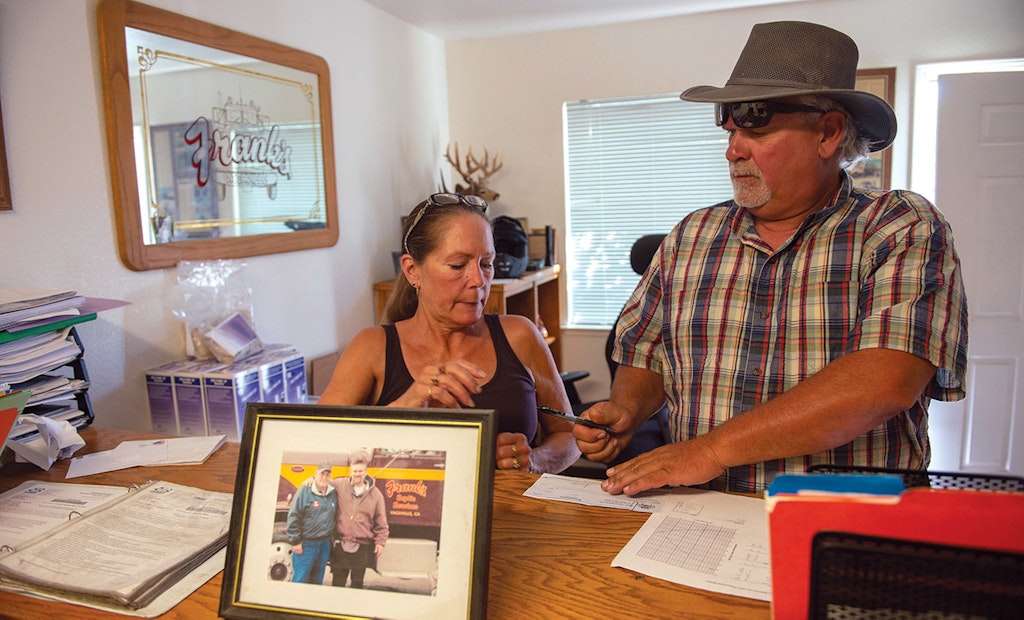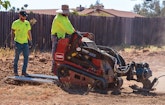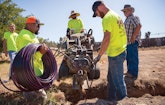
Owner Sean Bonifacio discusses the daily work schedule with Johanna Azevedo, the office manager at Frank’s Septic Services.
When Frank Bonifacio started his wastewater business in Vacaville, California, 70 years ago, he was in the right spot for the company to thrive. Vacaville is about 54 miles northeast of San Francisco in the agriculture-heavy Central Valley that runs for 450 miles up the middle of the state. Today the four counties served by the company contain more than three-quarters of a million people. There are plenty of businesses and rural properties that need service, and Frank’s Septic Services is still there to help.
It’s a bigger company now, especially in the last few years as it has added people and equipment for pumping, installing and system maintenance. Work is divided about 50-50 between pumping and installing/regular maintenance, says Scott Noble, the company’s operations manager.
GETTING CREATIVE
In their territory, there aren’t too many aerobic treatment units in use, Noble says. “We do more engineered systems.” That means, for example, Orenco Systems AdvanTex AX20 units paired with a drip system. The Frank’s Septic Services team has also started using Presby Environmental (Infiltrator Water Technologies) products. Gravity system installations are few, perhaps one to 10 annually, he says.
The company’s home county, Solano, has good soils in the northwest, Noble says. In the southeast and throughout much of the rest of the county, the soils are clay with limiting layers and high seasonal groundwater, says Sean Bonifacio, the company owner.
“We have to get really creative on what type of system to put in,” Noble says.
One factor installers always check is the size of the drainfield specified by an engineer. Standard calculations may call for 1,000 square feet of drainfield, he says, but the Frank’s Septic Services team insists on 2,000 square feet because they know from experience that a field sized according to accepted guidelines will quickly become overloaded in their soils.
Installation season starts around the end of March and continues into the fall, or whenever the rainy season begins.
“We’ve worked sometimes year-round or worked until Thanksgiving, and then we’re down for three to four months,” Noble says.
WINERY WORK
Vacaville is on the western edge of the Central Valley. To the west are the coastal hills and mountains and the valleys that form California’s famous wine country. Napa County is about a 30-minute drive from Vacaville. For Frank’s Septic Services, wine country means business because of all the wastewater generated by the vinting process.
Wineries typically have lagoons or some kind of wastewater storage. When they’re down to two or three days of capacity, Frank’s Septic Services gets a call, Noble says. One winery may produce two or three loads, and that will be a day’s work for one of the big tank trailers that hold 5,000 or 6,000 gallons, Noble says.
Disposal is either at the East Bay Municipal Utility District in Oakland, about 48 miles southwest of Vacaville, or the Yolo County landfill, which is about 27 miles north. Yolo County just established a large dumping station at its landfill site, Noble says. Heavier solids settle out in a large pit, and a series of canals take away the rest of the liquid and settle the lighter solids.
A worker monitors the site, and when it reaches capacity, the county halts dumping for a few days as workers clean out the solids. “Then you get the email saying they’re back open for business,” Noble says.
Frank’s Septic Services technicians don’t go far into wine country, Noble says, only 20 or 30 miles because there are plenty of other good providers farther inside Napa County.
When they’re not hauling winery wastewater, the big tanker trailers are still useful for other commercial jobs. For example, the company has a contract with a Vacaville restaurant to pump its grease trap. That happens every quarter, and it requires a big tanker to remove most of the waste and then a visit from one of the smaller vacuum trucks to do the final cleaning and clean the lift station. Residential tanks average about 2,000 gallons.
Trucks are on the road every day of the week except for some Saturdays, Noble says.
LOTS OF EQUIPMENT
To handle all this work, the Frank’s Septic Services team depends on:
• 2014 Peterbilt with a 2,500-gallon aluminum tank and National Vacuum Equipment 607 Challenger pump
• 2010 Mack cabover with a 2,500-gallon aluminum tank and Jurop/Chandler pump
• Eight 5,000-6,000 tanker trailers pulled by 2010 to 2012 Mack tractors
• Two Takeuchi excavators, a TB260 and TB016
• Case CX36B excavator
• Two tracked Takeuchi skid-steers, a TL140 and TL10V2
• Toro Dingo TX 1000 used for the vibratory plow for installing driplines
• 2018 Ford F-550
• 2007 Ford F-350
• Ford F-350 for hauling equipment
• 2007 Chevy Silverado 2500 service truck
The fleet has undergone major changes because of California’s engine-emissions rules. A few years ago, California began requiring truck owners to upgrade their fleets to newer and cleaner engines.
The process will end in 2023. Over this period, the state has a schedule of when vehicles from certain model years must meet new air rules. For example, from 2013 to 2021, heavy trucks (GVWR greater than 26,000 pounds) with engines built from 2000 to 2004 must have a filter to trap small particles of soot. After 2021, those trucks must have engines built in 2010 or later.
Fortunately, Noble says, the state’s scheduling did not require the company to replace all of its trucks at once. They could pick up one or two and sell others. “It was a slow process, but we now meet all the rules,” he says.
ADDING STAFF
Frank’s Septic Services has expanded with the workload. When Noble joined the company in 2007, just after owner Sean Bonifacio took over from his father, Alvin, there was one vacuum truck driver. Now there are enough so a customer with an urgent need can be served right away. There are six to eight drivers for the big tank trucks. Two to three people used to handle the installations; now it’s five to six, including Noble. One person used to handle the office work; now it’s two full-time people with one part-time person dedicated to answering phones and making sure registrations and insurance are current for the fleet.
All the company’s business is based on reputation and word-of-mouth, Noble says. For a long time, Bonifacio paid for ads in the local phone book, and when social media started, he became very active with that. “Then he realized that our phones were still ringing, and he was paying a lot of money for advertising,” Noble says. Bonifacio scrapped the advertising, and the phones kept ringing.
Busy as they are, it’s reasonable to ask whether Frank’s Septic Services could use a few more people. “We’re trying,” Noble says. But the labor force is not what it was 20 years ago, or even 10, he says. People are no longer committed to jobs.
“They want the paycheck, but they don’t want to work to earn it,” Noble says. “This is construction; it’s about production, and we need people who understand those commitments.
“Our economy is so good right now that it’s hard to find good help,” he continues. And there are people who apply for jobs but believe they should earn more despite a lack of experience. “There’s more to what we do, and we expect a lot, and they get frustrated and leave.”
Bonifacio is trying to find someone with electrical experience who can figure out problems, Noble says. Noble does scheduling, ordering materials, and county inspections, and he fills in on installation crews. When all employees are back at work, Noble consults the spreadsheet of systems that Frank’s Septic Services maintains. Some need to be checked quarterly, others only once every six or seven months. If he doesn’t need to fill in on trucks, he catches up on the service work and schedules more appointments with customers.
The company is just at the point where it’s offering health benefits including medical, dental and vision coverage, Noble says. That should encourage people to stay on, he says.
ON THE GROW
From 2010 to 2018, the population of the U.S. grew by 6%. Frank’s Septic Services’ home county of Solano grew by 8.1%, and the next county north, Yolo, grew by 9.7%. That’s more people and more potential customers, and the pace of work at Frank’s Septic Services is a testament to the growth. Bonifacio says he doesn’t have any particular plans for growth. What has happened to the company over the past decades happened naturally, he says; it all came about simply from meeting customers’ needs.
With the right people in place, the seed of a company that Frank Bonifacio planted 70 years ago will continue to grow and branch out toward the big California sky.
Keeping 70 years of onsite records
Locating a septic tank can hold up a job, unless you’ve taken the trouble to get ahead of the problem. At Frank’s Septic Services in California, the team has been good about encouraging customers to install risers to make the job easier, says Scott Noble, the company’s operations manager.
“We tell customers it’s a lot cheaper and easier for all of us if they let us put in a riser,” he says, “because there have been winters when we’re trying to dig up their septic tanks in the mud.”
Frank’s Septic Services marked 70 years in business in 2019, and the installation records from all those years are still in the company’s office. It’s amazing to look at files from the ’50s or ’60s, Noble says. It was before modern regulations and inspections, he says, and someone from the company would go to the county and say, ‘We’re putting this size tank on this property.’ And that’s all there was to it.
Those old records can come in handy when the Frank’s Septic Services team is trying to find an old tank. They can make a better guess at where to start digging.
“What’s funny is sometimes Solano County is calling us to say, ‘We don’t have a record,’” Noble says. When that happens, the Frank’s Septic Services team tries to help them out by looking in its own files.











